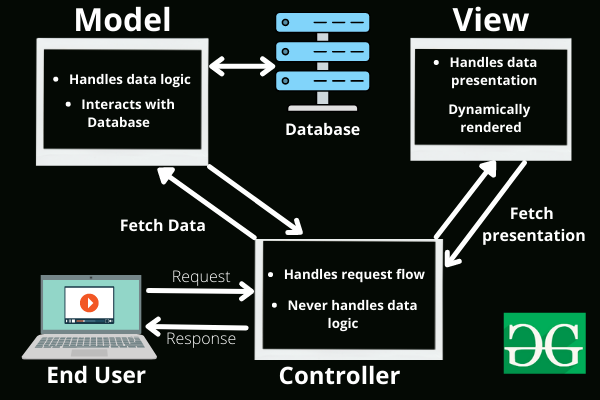The Unseen Evolution: Why Backbone.js News is Still Relevant in a React World
In a development landscape dominated by headlines about React News, the latest features in Vue.js, and the ever-shifting paradigms of Angular, it’s easy to assume that the foundational libraries of the web have been relegated to the history books. For years, frameworks like Backbone.js were the bedrock of single-page applications, introducing concepts like Models, Views, and Collections to a generation of developers. While the community buzz may have shifted towards component-based architectures discussed in Svelte News or the server-side rendering powerhouses featured in Next.js News, a fascinating undercurrent of innovation persists. The core principles that made Backbone.js so revolutionary—simplicity, flexibility, and a clear separation of concerns—are not just surviving; they are being reimagined.
Recent developments in the JavaScript ecosystem have sparked a quiet renaissance. Developers who appreciate the unopinionated, lightweight nature of classic MVC (Model-View-Controller) patterns are building new tools that embrace modern JavaScript features. This isn’t about clinging to the past; it’s about evolving proven architectural patterns for the future. These next-generation frameworks offer a compelling alternative for projects where the overhead of a virtual DOM or a complex state management library is unnecessary. This article explores this modern evolution, delving into the core concepts, practical implementations, and advanced techniques that are making Backbone.js News surprisingly relevant again.
Section 1: Revisiting the Core: The Enduring Principles of Backbone.js
To understand where we’re going, we must first remember where we came from. Backbone.js provided a minimal set of building blocks for structuring web applications. Its power lay not in what it did, but in what it enabled developers to do. The key components were Models, Collections, Views, and a Router.
The Classic Building Blocks
- Models: Represented the data of an application. They contained the interactive data as well as the logic around it. Models could emit change events, which was a cornerstone of its reactivity.
- Collections: Ordered sets of Models. They provided a rich API for managing groups of data, including sorting, filtering, and proxying events from their models.
- Views: Handled the UI logic. A View’s primary role was to listen to events on a Model or Collection and render or re-render the HTML accordingly. Crucially, Backbone Views didn’t dictate a templating engine, giving developers complete freedom.
- Router: Provided URL routing for single-page applications, allowing for bookmarkable and shareable URLs that mapped to specific application states.
This separation was clean and effective. Data logic lived in Models, UI logic in Views, and application state was managed through the Router. Let’s look at a classic example of a simple “Todo” item view.
// Classic Backbone.js Todo Item Example
// The Model for a single Todo item
var Todo = Backbone.Model.extend({
defaults: {
title: '',
completed: false
}
});
// The View for a single Todo item
var TodoView = Backbone.View.extend({
tagName: 'li', // Renders the view inside an <li> tag
template: _.template('<%= title %> <input type="checkbox" <%= completed ? "checked" : "" %> />'),
events: {
'change input': 'toggleCompleted'
},
initialize: function() {
// Re-render the view if the model changes
this.listenTo(this.model, 'change', this.render);
},
render: function() {
this.$el.html(this.template(this.model.toJSON()));
return this;
},
toggleCompleted: function() {
this.model.set('completed', !this.model.get('completed'));
}
});
// Usage
var todoModel = new Todo({ title: 'Learn Backbone.js', completed: true });
var todoView = new TodoView({ model: todoModel });
// Append the rendered view to the DOM
$('#todo-list').append(todoView.render().el);This pattern, while verbose by today’s standards, is incredibly clear. The View is explicitly tied to a Model, listens for its changes, and knows how to render itself. This foundational approach influenced countless libraries and is still a powerful mental model for application architecture, even as tooling evolves with updates in Webpack News and Vite News.
Section 2: The Next Generation: Modernizing the MVC Pattern

The core issue with classic Backbone wasn’t its architecture but its syntax and reliance on older JavaScript patterns and libraries like Underscore.js and jQuery. Modern successor frameworks are tackling these issues head-on by integrating ES6+ features, embracing a more declarative style, and shedding legacy dependencies.
Key Modernizations
- ES6 Classes: Replacing
.extend()with native JavaScript classes makes the code cleaner, more intuitive for developers coming from other languages, and enables better static analysis. - No jQuery Dependency: By using standard DOM APIs like
querySelectorandaddEventListener, these new frameworks become lighter and remove a major dependency that is often no longer needed in modern browsers. - Declarative Rendering: While classic Backbone Views were imperative (you manually called
render()), modern takes often adopt a more declarative or reactive approach, where the view automatically updates when its associated state changes, similar to what’s seen in Vue.js News. - Component-like Structure: Views are treated more like self-contained components, often managing their own internal state and lifecycle hooks (e.g.,
onConnect,onDisconnect), which brings them closer in concept to components in React or Vue.
Let’s reimagine the previous TodoView using a hypothetical modern, Backbone-inspired framework that uses these principles.
// Hypothetical "NextGen" Framework Example using ES6 Classes
// The Model remains conceptually similar but uses a class
class TodoModel extends NextGen.Model {
constructor(attributes) {
super({
title: '',
completed: false,
...attributes,
});
}
}
// The View now feels much more like a modern component
class TodoView extends NextGen.View {
// Define the model this view is associated with
model = new TodoModel();
// Declarative event bindings
events = {
'change input': 'toggleCompleted'
};
// Template is a simple string. No external dependency needed.
get template() {
return `
<span class="${this.model.get('completed') ? 'done' : ''}">
${this.model.get('title')}
</span>
<input type="checkbox" ${this.model.get('completed') ? 'checked' : ''} />
`;
}
// The render logic is now handled automatically by the framework
// when the model changes. We just define the template.
toggleCompleted() {
this.model.set('completed', !this.model.get('completed'));
}
}
// Usage
const myView = new TodoView();
myView.model.set({ title: 'Explore Modern MVC' });
// Mount the view to the DOM
document.getElementById('todo-list').appendChild(myView.el);This modernized approach is significantly cleaner. The events hash remains a powerful and elegant pattern, but the overall structure leverages modern JavaScript. The manual call to render() and the explicit listenTo are abstracted away, providing a better developer experience without sacrificing the underlying MVC separation. This evolution is crucial, as it allows teams to leverage the simplicity of MVC with the tooling and syntax highlighted in TypeScript News and ESLint News.
Section 3: Advanced Techniques and Ecosystem Integration
A framework’s true power lies in its ability to integrate with the broader ecosystem. Modern Backbone-style libraries are not islands; they are designed to work seamlessly with the tools that define contemporary web development. This is where they truly shine, offering a lightweight core that can be augmented as needed.
Integrating with Modern Build Tools
Gone are the days of manually including script tags. A modern MVC project can be set up with Vite, Webpack, or Rollup in minutes. This provides access to features like Hot Module Replacement (HMR), tree-shaking, and optimized production builds—topics frequently covered in Vite News and Turbopack News.
Here’s a simplified example of how a view file might look in a project bundled with Vite, using JavaScript modules.

// src/views/UserCardView.js
import { View, Model } from 'modern-mvc-library';
import { fetchUserData } from '../services/api';
// Define a model for our user data
class UserModel extends Model {
constructor(attributes) {
super({
name: 'Loading...',
email: '',
avatarUrl: '/default-avatar.png',
...attributes
});
}
async fetchUser(userId) {
const userData = await fetchUserData(userId);
this.set(userData);
}
}
// Define the view component
export class UserCardView extends View {
model = new UserModel();
tagName = 'div';
className = 'user-card';
// Lifecycle hook, called when the view is added to the DOM
onConnect() {
const userId = this.el.dataset.userId;
if (userId) {
this.model.fetchUser(userId);
}
}
// Template is automatically re-rendered on model change
get template() {
return `
<img src="${this.model.get('avatarUrl')}" alt="User Avatar" />
<div class="user-info">
<h3>${this.model.get('name')}</h3>
<p>${this.model.get('email')}</p>
</div>
`;
}
}
// src/main.js
import { UserCardView } from './views/UserCardView';
// Instantiate and mount the view
const userCard = new UserCardView();
document.getElementById('app').appendChild(userCard.el);State Management and Inter-Component Communication
While frameworks like those in RedwoodJS News or Blitz.js News often come with prescribed data layers, Backbone-inspired libraries offer flexibility. For simple cases, communication can be handled with a global event bus (a pattern Backbone pioneered with Backbone.Events). For more complex applications, these libraries can be integrated with dedicated state management solutions like Redux, MobX, or Zustand, allowing developers to choose the right tool for the job without being locked into a specific ecosystem.
This flexibility is a significant advantage. You can start with simple model-view bindings and scale up to a full-fledged state management library only when the application’s complexity demands it, avoiding premature optimization. This contrasts with the all-in-one approach of frameworks like Angular or Meteor.
Section 4: Best Practices and Choosing the Right Tool
With so many options available, from the minimal Alpine.js News to the comprehensive Angular News, when does it make sense to choose a modern MVC framework? The answer lies in the project’s requirements and the team’s philosophy.

Ideal Use Cases
- Multi-page Applications with Islands of Interactivity: These frameworks are perfect for enhancing traditional server-rendered applications. You can “sprinkle” interactive components onto a page without the overhead of a full SPA framework.
- Projects Prioritizing Performance and a Small Bundle Size: With a minimal core, the final bundle size can be significantly smaller than that of larger frameworks. This is critical for content-heavy sites or applications targeting users with slower network connections.
- Applications with Complex, Relational Data: The Model-Collection paradigm is exceptionally good at managing structured data. For dashboards, admin panels, or data visualization tools, this can be more intuitive than a component-tree-based state model.
- Teams that Value Flexibility: If you want to choose your own templating engine, data-fetching library, and state management solution, the unopinionated nature of these frameworks is a major benefit.
Common Pitfalls to Avoid
Despite their advantages, it’s important to be mindful of potential challenges. Without the rigid structure of a framework like Angular, it’s easier to write disorganized “spaghetti code.” To avoid this, teams should establish clear conventions for file structure, state management, and communication between views. Adhering to SOLID principles and keeping views small and focused is paramount. Furthermore, while the testing story is strong with tools discussed in Jest News and Cypress News, it requires discipline to write testable, decoupled code.
Conclusion: The Enduring Value of Simplicity
The world of front-end development is not a zero-sum game. The excitement surrounding Remix News or the performance gains highlighted in SolidJS News doesn’t invalidate other architectural patterns. The resurgence of interest in Backbone’s core ideas, refitted with modern JavaScript syntax and tooling, is a testament to the enduring power of simplicity and separation of concerns.
These next-generation MVC frameworks provide a compelling middle ground. They offer more structure than a micro-library like jQuery but avoid the high complexity and boilerplate of full-scale frameworks. For developers and teams who value performance, flexibility, and a clear, understandable architecture, the latest Backbone.js News is that its spirit is alive and well, powering a new generation of fast, maintainable, and elegant web applications. The next time you start a project, it may be worth looking beyond the usual suspects and exploring this revitalized approach to building for the web.

